
During the past several years, mobility systems have faced fundamental changes and new dynamics provided by different travel options by land, air, and sea, including bicycles, two & three-wheelers, train rides (metro, intra-city, inter-city), passenger cars, ridesharing (3W or 4W), buses, boats, and aircraft.
Mobility has been broadly classified as ‘intermodal travelling’ to describe the use of different transport modes on a single route and ‘multimodal travelling’ to define the use of different transport modes on different routes. In many countries, it is common to see travellers using different modes of transport for regular commute, to cover the short-range and long-range transportation needs, as can be seen in Figure 1 [1].
Owing to significant awareness on global climate change and the need for sustainable mobility, many of these transportation modes are adopting “green” technologies to reduce air pollution. Governments in different countries are working closely with Telecom Service Providers (TSPs) to offer free/ limited Wi-Fi connections in train stations, airports, inner cities etc. to not only encourage more travellers to adopt public transportation and ridesharing travel options but also to provide them “ubiquitous network” and “mobile computing” opportunities.
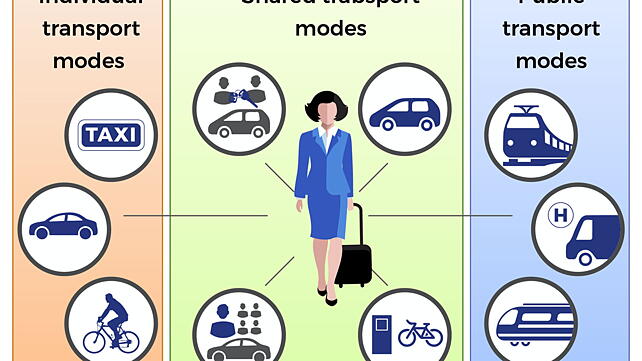
Next, Edge Computing architectures and opportunities for different transport modes including ground vehicles, unmanned aerial vehicles, and high-speed trains are presented.
Internet Of Vehicles & Vehicle Edge Computing
The continuous evolution and recent technological advances of Cyber Physical Systems (CPS) has led to the pervasive use of smart vehicles, while enabling various types of powerful mobile applications, which usually require high-intensity processing under strict delay constraints. For mobility applications, the concept of Internet of Vehicles (IoV) has come into the fore that connects smart and intelligent vehicles to any other entities around them, such as vehicles, infrastructure, pedestrians, networks, grids, UAVs, etc., through vehicle-to-everything (V2X) or cellular V2X (C-V2X) technologies. An overview of IoV framework is depicted in Figure 2 [2].
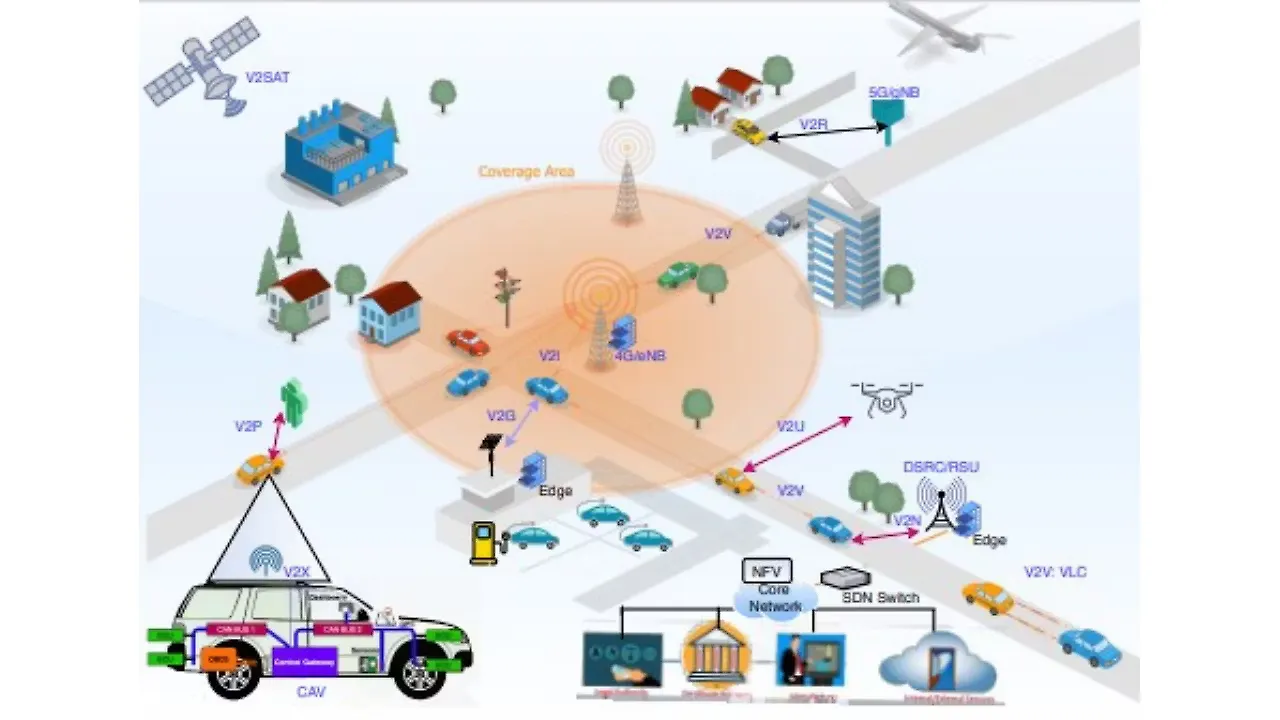
Smart vehicles inherently come with powerful vehicular applications, such as autonomous driving, voice recognition, in-vehicle entertainment, advanced safety etc. and help to build a smarter, safer, and more sustainable transportation system. These applications usually require intensive computational processing.
However, constrained by on-board computing resources, an individual smart vehicle might not provide sufficient computing power, which makes it difficult to ensure that application tasks are completed on time. The concept of Mobile Edge Computing (MEC) is proposed to facilitate local task handling, computation, data privacy, and reduced latency, as shown in Figure 3 [3].
By deploying computing servers in vehicular access networks, application tasks can be offloaded to the network edge for efficient execution. The offloading process leverages the wireless links between smart vehicles and roadside units (RSUs) for task data delivery and the acquisition of processing results in what is referred to as Vehicular Edge Computing (VEC).
In VEC, smart vehicles that have spare computing resources can be exploited as edge computing servers to serve adjacent vehicle task generators in V2V communication. The challenges in VEC management, unlike a traditional MEC designed for handheld mobile devices, include:
- Highly dynamic topology and unstable service relationships due to fast movement of vehicles;
- Complex vehicular communication environment for task offloading and handover from one RSU to another;
- Edge node heterogeneity due to rapidly changing traffic and driving conditions and decentralised and independently controlled edge service nodes, and
- Strict low latency constraints and large amounts of task data handling, processing, and decision making for enabling ADAS operations and (semi) autonomous driving capabilities.
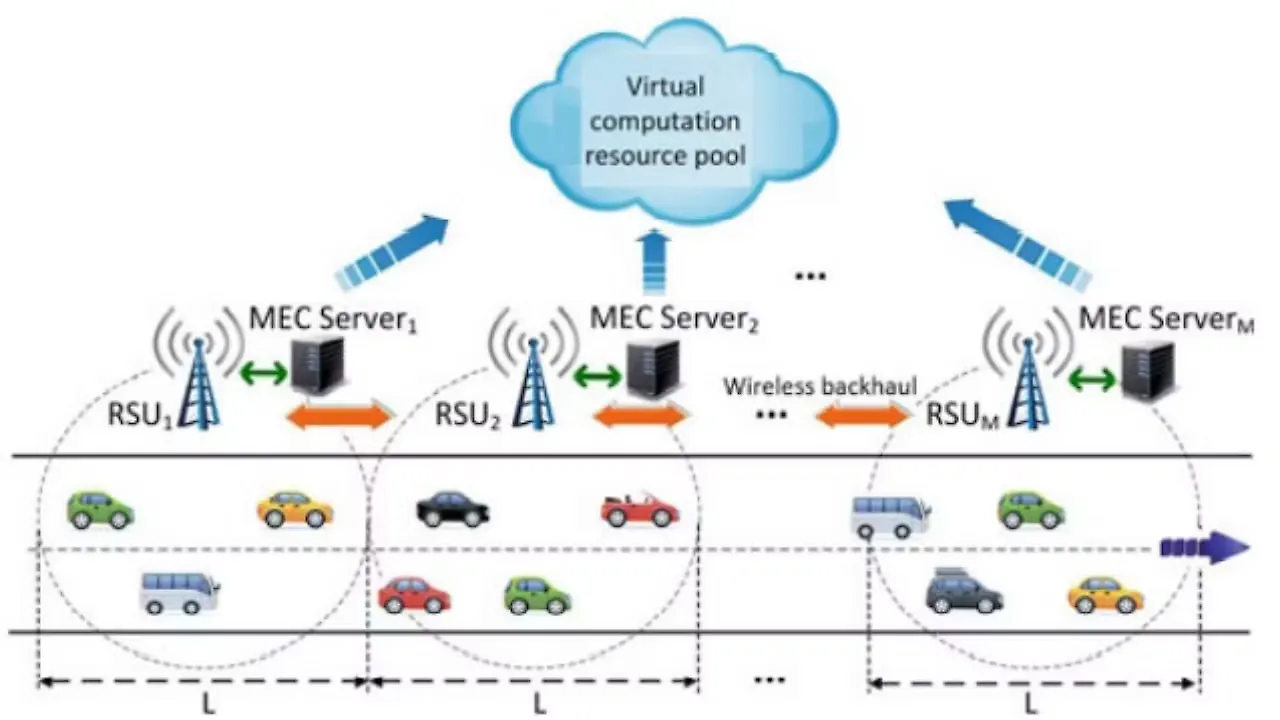
AI-Empowered VEC
AI-empowered VEC investigates the characteristics of edge computing from both the application and service perspectives and introduces a hierarchical edge computing framework and resource scheduling schemes to achieve efficient task offloading. The optimal solution should be aware of the network environment, understand the service requirements, and consider numerous other factors in edge management.
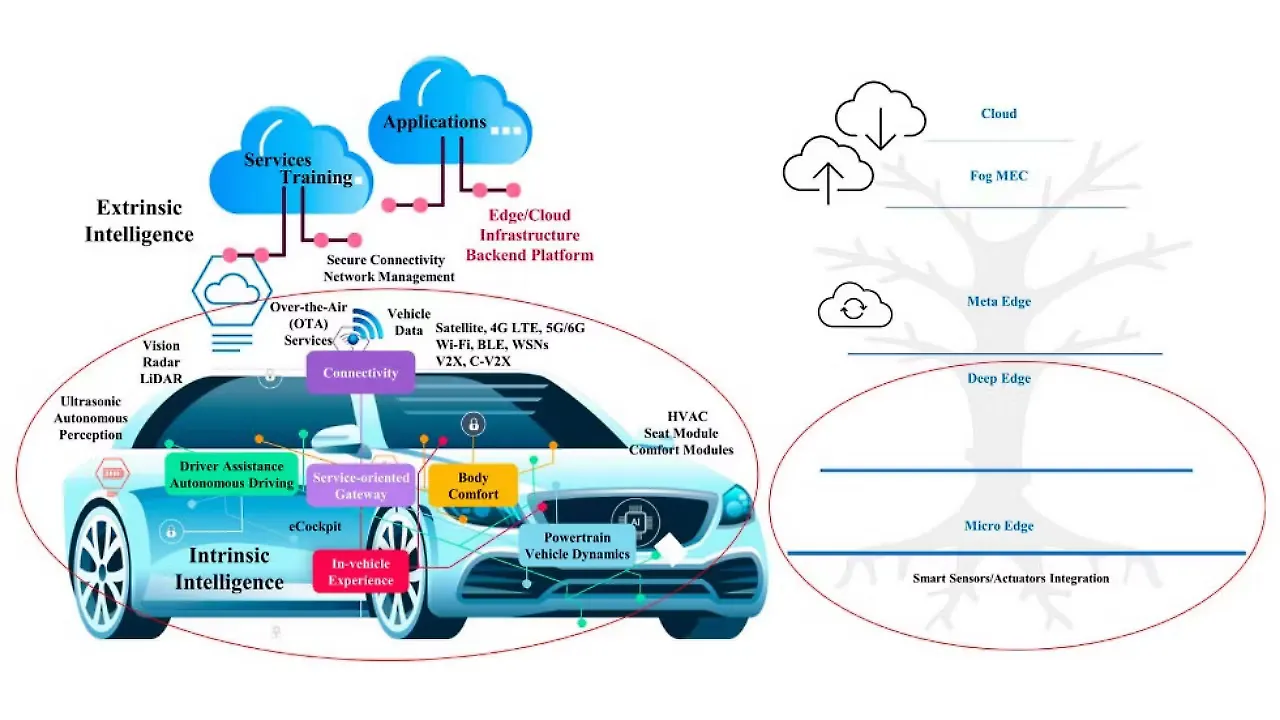
AI applications in Connected and Autonomous Vehicles (CAVs) include Extrinsic & Intrinsic Intelligence, as shown in Figure 4 [4]. The Extrinsic Intelligence primarily handles applications, communications with edge/Cloud backend platform, and services training. The Intrinsic Intelligence includes perception domain (sensors, data acquisition & data fusion), powertrain vehicle dynamics (driving comfort, range optimisation, HVAC controls etc.), Advanced Driver Assistance Systems (ADAS), Over-the-Air (OTA) services, In-Vehicle Infotainment (IVI) and connectivity.
Four different kinds of edge computing environments can be observed in Figure 4, including Micro, Deep, Meta, and Fog. While Micro Edge and Deep Edge technologies apply mainly to the intrinsic vehicle intelligence, Meta Edge applies to both intrinsic and extrinsic vehicle intelligence.
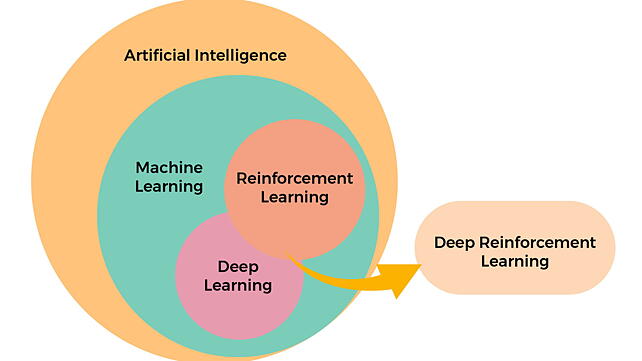
AI and its subset of technologies are depicted in a Venn diagram in Figure 5 [5] and play an important role in making vehicle networks intelligent. Various types of Machine Learning (ML) techniques have been applied in VEC, among which Reinforcement Learning (RL), regarded as delayed supervised learning, is the most important.
RL makes agents gain experience from their interactions with the environment and adjust action strategies along the learning process. RL is suitable for dynamic road traffic states and complex vehicular networks. However, RL is found to have shortcoming in the edge management of large-scale networks handling massive amounts of state information, especially states represented by continuous values.
To overcome this shortcoming, deep Q reinforcement learning (DQL) is proposed, which uses a Q-function as an approximator to capture complex interactions among various states and actions. Q-learning is a typical time-difference RL algorithm in ML. Further, in the dynamically changing environment of vehicular networks, some offloading actions could be chosen from a continuous space, such as wireless spectrum allocations and transmission power adjustments, as shown in Figure 6 [3].
The Deep Reinforcement Learning (DRL), a subset of DL and RL shown in Figure 5, is applied to address the demands of edge service scheduling and utilises deep deterministic policy gradient learning (DDPGL) that concurrently learns and optimises policy and value functions.

Deep-Q learning (DQL) algorithms can intelligently control the use of network resources in IoV. DQL for vehicular computation offloading can be understood considering an MEC-enabled vehicular network in an urban area, as illustrated in Figure 6 [3]. In this vehicular network, in addition to a cellular Base Station (BS), multiple number of Roadside Units (RSUs), each with an MEC server, are shown.
In the heterogeneous network formed by the overlapping coverage of the BS and the RSUs shown in Figure 6, vehicles can offload their tasks to the MEC servers through multiple modes. A task is typically described in four terms, viz, size of the task input data, amount of time & processing required for computation, maximum time delay tolerance of the task, and the efficiency of communication.
While V2I addresses the task file transmission between a vehicle and the BS, V2V communication method is used for V2V task offloading. When a vehicle turns to the LTE-Vehicle network for task offloading, the file can be transmitted to an MEC server in a joint V2V-V2R transmission mode. A DQL-based joint MEC server selection and offloading mode determination scheme proposed to formulate an optimal offloading problem is found to yield higher offloading utility. This is because the DQL-based scheme jointly considers transmission efficiency and the load states of the MEC servers [3].
IoD, Edge Computing Using UAVs
Over the past few years, unmanned aerial vehicles (UAVs) and drones have been extensively used in diverse areas such as battle fields for military, crowd control and safety assurance, precision agriculture, land surveys, internet hotspots, goods and medicine deliveries especially in difficult terrains, and disaster management during floods, volcanoes and landslides.
Besides UAV technologies, edge computing is promising since it can significantly improve the computation capacity of the finite-energy and computation-constrained mobile devices. Of late, MEC assisted by UAVs is garnering significant attention compared to conventional terrestrial MEC networks because of the advantages it offers, including flexible deployment in scenarios, where terrestrial MEC networks might not be convenient, fully controllable mobility, and strong line-of-sight (LoS) channels with ground-based devices.
The UAV-enabled MEC network, shown in Figure 7 [3], can be flexibly deployed in most scenarios even in wilderness, desert, and complex terrains, where the terrestrial MEC networks may not be conveniently and reliably established. The UAV-enabled MEC network can be particularly helpful in situations, where conventional terrestrial MEC systems are destroyed by natural disasters.
The computation performance in UAV-enabled MEC network can be improved since there is a high possibility that short-distance line-of-sight (LoS) links exist for offloading of computation tasks and downloading of computation results. Furthermore, the trajectory of the UAV can be optimised to further improve the user computation performance.

In the UAV-enabled MEC architecture, a UAV can be considered as a user or relay or MEC server by properly using computing resources at the edge of network to decrease processing latency and to improve the utilisation efficiency and performance of UAV-enabled edge computing network. As depicted in Figure 8 [6], a UAV can be considered as a user that can exploit MEC computing capabilities, or as an MEC server for executing computation tasks or as a relay to assist users for offloading computation tasks.
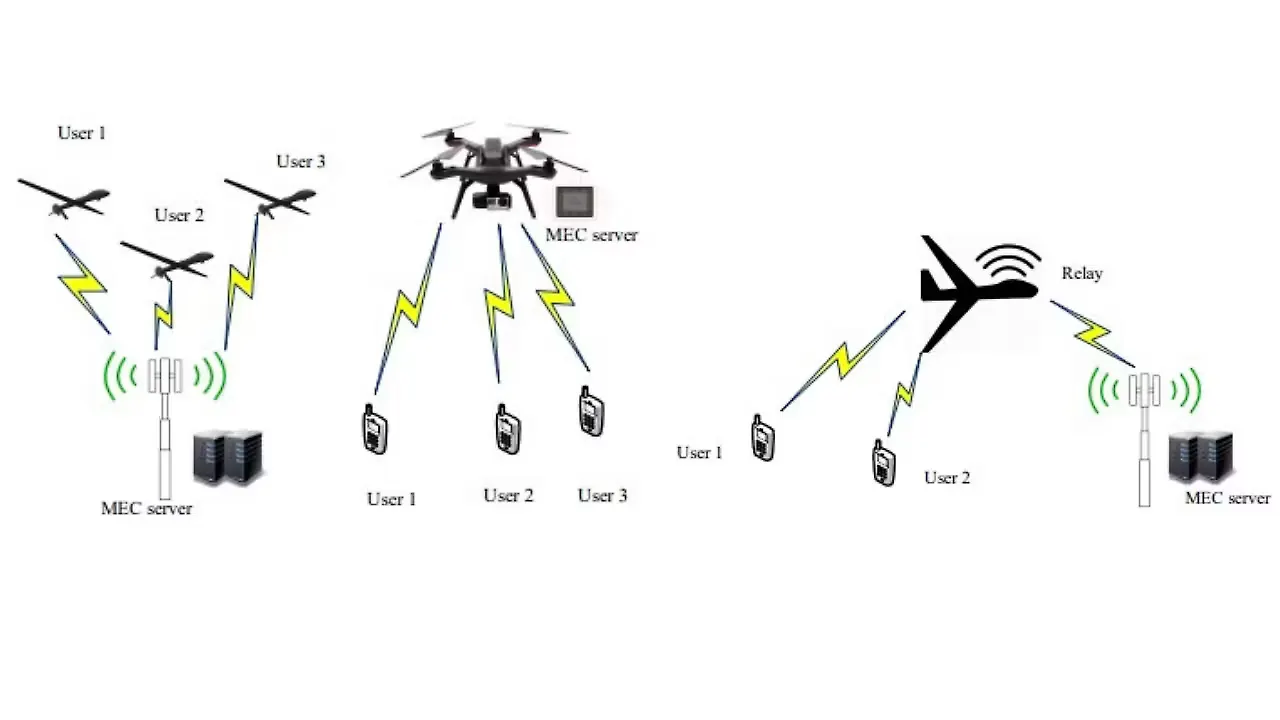
In Figure 9, UAV swarm enabled MEC network and edge computing is showcased, wherein UAVs appear in formation or in swarm, inspired by the swarming behaviours of wild creatures in nature. In this architecture, dedicated UAVs in the swarm are equipped with computing elements to assist data processing locally or through fine-grained offloading.
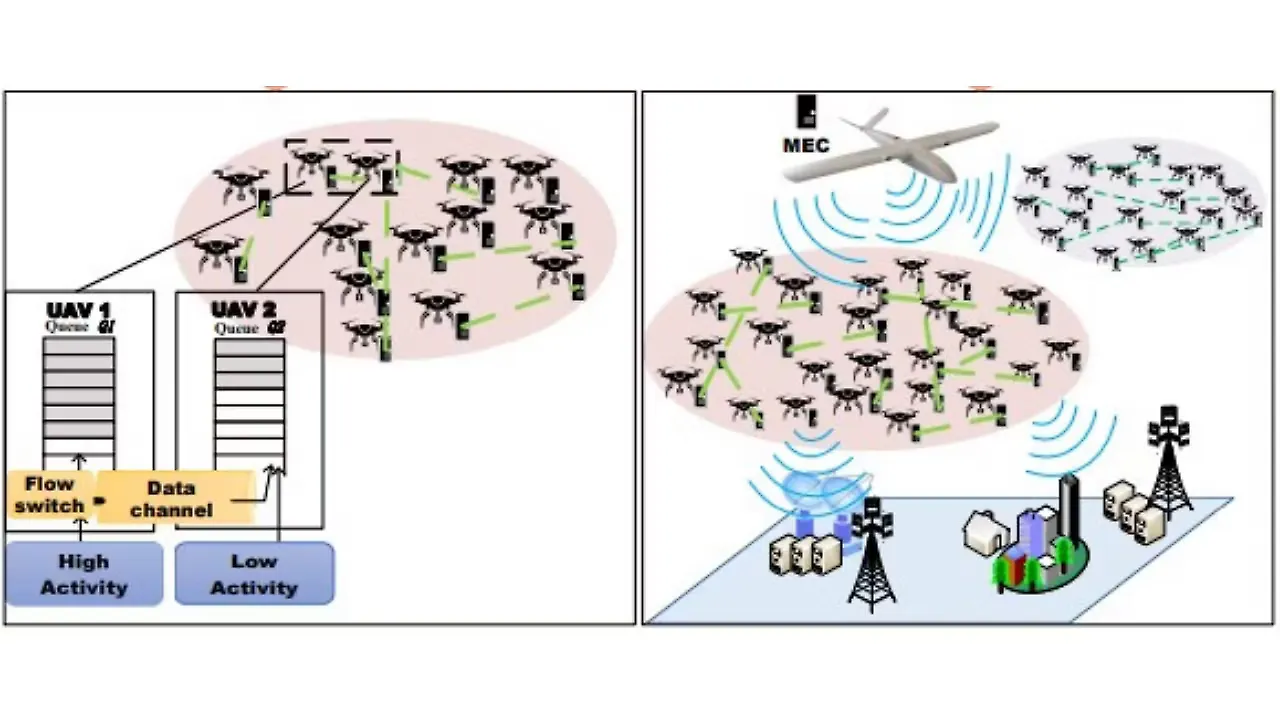
The potential application scenarios and UAV swarm-enabled edge computing architectures include: a) large-scale military deployment in battle fields; b) geological observations; c) precision agriculture; and d) disaster management and goods delivery. This is because compared to the conventional single UAV or small number of UAVs enabled edge computing networks, the UAV swarm enabled edge computing networks can tackle more complex missions and provide strong support to embrace the forthcoming era of Internet of Drones (IoD).
This promising technology has many appealing advantages, including, a) significantly improved task execution capability; b) enhanced offloading security; c) high fault tolerance, and d) helpful UAV-to-UAV communications.
Under an emergency scenario, terrestrial MEC infrastructures could be destroyed in a disaster, leaving many rescue tasks unable to be computed or executed. UAVs mounted with edge servers, as shown in Figure 8(b) or in the form of a swarm as shown in Figure 9, could be dispatched to compute the rescue tasks in time.
It is sometimes difficult to establish terrestrial MEC networks to compute inspection tasks, such as for turbines at offshore wind farms or power lines in a smart grid or mobile communication towers in remote hilly terrains, due to a harsh environment. In this case, a UAV-assisted MEC network can play a very important role. In hotspots, the high volumes of computation tasks offloaded from millions of mobile users can exhaust the computation resources of edge servers, which leads to increased processing latency that decreases the user’s quality of experience (QoE).
The assistance of UAVs can improve the user’s QoE. Furthermore, it is expected that UAVs will have full autonomous clustering ability by 2025, which will provide the UAV swarm with powerful capability.
AI-Enabled Edge Computing in High-Speed Trains (HST)
In recent years, High-Speed Trains (HSTs) have been operating in many countries across the world at speeds exceeding 350 km/h. As many passengers spend few hours traveling in these HSTs, they tend to communicate and transfer data extensively via mobile devices. It is necessary to assure the QoE for the users due to frequent handover between mobile towers traveling at high speeds in these HSTs. The handover failures increase with higher moving speeds and have been identified as one of the critical challenges facing communication systems for real-time services in HSTs.
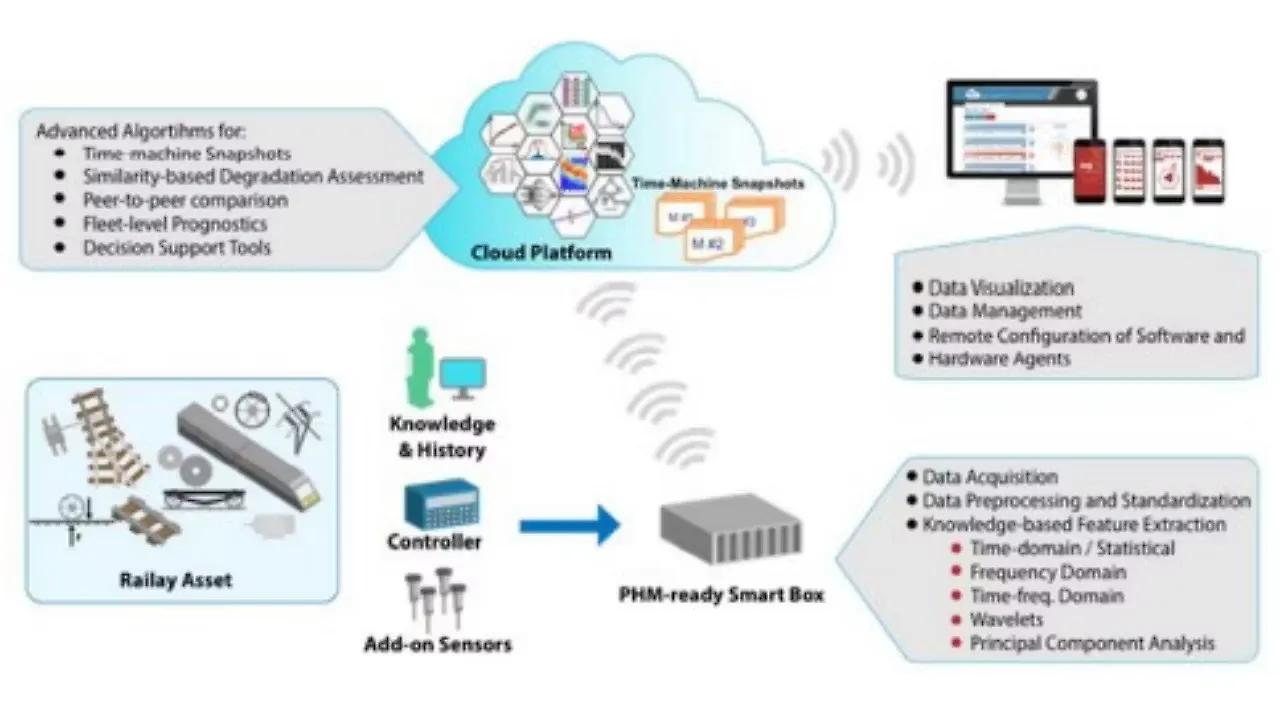
A schematic of Cyber-Physical System (CPS) framework and edge computing for HST is shown in Figure 10 [8] to enable systematic and scalable application of AI technologies for enhanced QoE and prognostics and health management. The CPS framework serves as a platform that incorporates recent technology advances in industrial AI and industrial IoT (IIoT) to create “Cyber Twins” of physical applications for real-time services and asset health transparency and rapid decision-making.
AI-enabled edge computing finds multiple use cases in HSTs, including:
Higher computing power onboard trains: There is a dire need for big computing power in small spaces onboard HSTs. Railways can build enough processing power to run a variety of AI workloads at a pace that keeps up with real-time demands. AI enabled edge computing solutions include GPU-powered systems with video analytics platforms that can watch the rails via a front-facing camera to detect hazards and trigger an immediate response, when necessary to keep passengers safe.
Distributed computing throughout rail network: Multi-access edge computing (MAEC) facilitates real-time analytics at the end to power AI applications and data distribution service, which enables communications between embedded systems, allowing data to flow freely between systems, equipment, processes, and people. MAEC 5G edge servers can be used to build private 5G networks for railways and enable rail MEC and AI applications.
5G networks have the potential to innovate the railway industry by enabling higher communication speeds, low latency, less reliance on wireless network providers, and greater security. They also have the power to advance railway digitalisation with improved infrastructure monitoring and greater sustainability in railway operations, optimising power generation to meet demand and minimising greenhouse gases (GHGs).
Reliable and safe data transfer and communication via mobile devices for passengers: Achieving seamless mobile connectivity in HSTs is a major challenge due to too frequent handover problems as well as the high probability of handover failure caused by the high speed of the train. In [9], the authors propose a multi-Radio-Access-Technology (multi-RAT) hybrid handover 5G scheme to overcome this problem, wherein both vertical and horizontal handovers are carried out simultaneously in a heterogeneous multi-RAT network.
Two antennas mounted at the front and rear ends of the train are used to integrate the dual-link scheme for vertical and horizontal handovers. The 5G network tier is implemented to achieve higher data rates and larger bandwidth, which is a fundamental requirement for delivering multi-Gbps backhaul connectivity to hundreds of user equipment on board. The 5G network tier is designed in such a way that it would recognise the users, who frequently visit the cell, defined as “user-friendly” for this cell.
As HSTs travel on specific rails in pre-defined routes with predictable trajectory and position, keeping the records and tracking the movement information of the “user-friendly” will aid in selecting predefined handover locations, where the handover criterion is met omitting the time to trigger (TTT), which causes a delay and radio link failure. The results obtained using multi-RAT network architecture indicate that the proposed method: a) decreased the probability of handover failure to a negligible value, b) successfully improved the QoE, and c) preserved seamless connectivity in the high-speed environment.
Prognostics and Health Management (PHM), which creates cyber twins of physical key subsystems and components to improve the condition transparency and decision efficiency. Enabled by advanced signal processing and machine learning with domain insights on historical data, cyber twins monitor real-time performance and predict potential faults to prevent unexpected downtime and support optimised decisions [8]. Instead of performing analytics with large amount of raw data on the cloud, the cyber railway transportation system leverages the advantage of edge computing for real-time feature extraction and anomaly detection.
Conclusion
For sustainable mobility, achievement of ‘net zero’ goals, and realisation of smart cities, it is imperative that we actively embrace multimodal and intermodal mobility. MEC can be used effectively in multimodal mobility in different applications, including ground vehicles, UAVs and HSTs. AI-enabled Edge Computing is enabling us to realise IoV for connected and autonomous ground vehicles and IoD for swarm-based UAVs.
AI enabled edge computing, with specific emphasis on Industrial AI and Industrial IoT (IIoT) is increasingly finding use cases for improving voice communication and data transfer for passengers as well as PHM of hardware in HSTs.
Future Work
MEC can offer a series of edge services with task processing, data storage, heterogeneity support, and QoS improvement capabilities. In close proximity to devices, MEC can provide instant computing applications with low latency and fast service response. The distributed structure of edge computing also potentially facilitates ubiquitous computing services, scalability, and network efficiency improvement.
However, the MEC infrastructure still has unresolved challenges in terms of security and privacy. First, the large amount of heterogeneous data being collected, transferred, stored, and used in dynamic MEC networks can easily suffer serious data leakage. Further, due to the high dynamism and openness of MEC systems, it is very challenging to save the setting and configuration information of the edge servers in a reliable and secure way.
Blockchain can enhance the security and privacy of MEC by offering many promising technical properties, such as decentralisation, privacy, immutability, traceability, and transparency. The integration of blockchain and MEC can enable secure network orchestration, flexible resource management, and system performance improvements. Future work should focus on offering Security-Enhanced AI in MEC by integrating blockchain with federated learning to provide trust, security, and intelligence in MEC systems.
For HSTs, further work is underway to improve the multi-RAT hybrid handover 5G scheme for more efficient voice communication and data transfer. Future work must follow the framework of High-Speed Railway (HSR) Cyber-Physical System (CPS) and design an extensible platform solution; select one critical scenario with minimal viable combination of technologies for fast validation and scale up the solution for comprehensive deployment.
References:
[1] Helga, J. et. al, “Understanding Multimodal and Intermodal Mobility,” Sustainable Urban Transport. Published online: 14 May 2015; 149-176. http://dx.doi.org/10.1108/S2044-994120150000007018
[2] Singh, P.K. et. al, “Blockchain meets AI for resilient and intelligent Internet of Vehicles,” IEEE COMSOC MMTC Communications - Frontiers Vol. 16, No. 6, November 2021, Page 12-24 https://arxiv.org/abs/2112.14078
[3] Zhang, Y., “Mobile Edge Computing,” Simula Springer Briefs on Computing Vol. 9, https://doi.org/10.1007/978-3-030-83944-4
[4] Vermesan, O. et. al, “Automotive Intelligence embedded in Electric Connected Autonomous and Shared Vehicles Technology for Sustainable Green Mobility,” Frontiers in Future Transportation, Vol. 2, Aug 2021, Article 688482, https://doi.org/10.3389/ffutr.2021.688482
[5] Hongjing, J. et. al, “Artificial Intelligence-Empowered edge of vehicles: Architecture, Enabling technologies, and Applications,” IEEE Access Vol. 8, https://doi.org/10.1109/ACCESS.2020.2983609
[6] Zhou, F. et. al, “Mobile Edge Computing in Unmanned Aerial Vehicle Networks” IEEE Wireless Communications, Vol. 27, No. 1, pp. 140-146, Feb 2020, https://doi.org/10.1109/MWC.001.1800594
[7] Wu, W. et. al, “Unmanned aerial vehicle swarm-enabled edge computing: Potentials, Promising Technologies, and Challenges”,https://arxiv.org/pdf/2201.08517
[8] Liu, Z. et. al, “Industrial AI enabled Prognostics for High-Speed Railway Systems, IEEE International Conference on Prognostics and Health Management (ICPHM), June 2018 https://doi.org/10.1109/ICPHM.2018.8448431
[9] El Banna, R. et. al, “Handover scheme for 5G communications for High-Speed Trains” Fifth International Conference on Fog and Mobile Edge Computing (FMEC), April 20-23, 2020 https://doi.org/10.1109/FMEC49853.2020.9144880
About the Author: Dr Arunkumar M Sampath works as a Principal Consultant in Tata Consultancy Services (TCS) in Chennai. His interests include Hybrid and Electric Vehicles, Connected and Autonomous Vehicles, Cybersecurity, Extreme Fast Charging, Functional Safety, Advanced Air Mobility (AAM), AI, ML, Data Analytics, and Data Monetization Strategies.